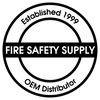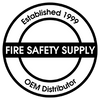UN103 Label-UN1013
Introduction
To ensure portable fire extinguishers are available and function properly when needed, both federal certification requirements and state licensure regulations mandate that healthcare facilities conduct proper inspection, testing, and maintenance. Unless stated otherwise, this guide will focus on federal certification requirements.
Applicable standards
NFPA 101(00), Sec. 9.7.4.1 and MSFC(07), Sec. 906.2 require that portable fire extinguishers be inspected and maintained in accordance with NFPA 10, Standard for Portable Fire Extinguishers. NFPA 101(00), Sec. 2.1.1 references the 1998 edition of NFPA 10. MSFC(07), Chapter 45, on the other hand, references the 2002 edition of the standard. For purposes of this guide, all code references will be based on the 1998 edition of NFPA 10.
Visual inspections
Portable fire extinguishers must be visually inspected when first placed into service and at least monthly thereafter. These inspections, designed to ensure each extinguisher is in its designated location and ready for operation, can be conducted by facility staff.
Maintenance
“Maintenance” involves a thorough examination and repair, as needed, of a facility’s portable fire extinguishers and is outlined in NFPA 10(98), Sec. 4-4. Maintenance is required at least once a year or more frequently if issues arise during routine monthly inspections. It is also necessary whenever extinguishers undergo hydrostatic testing.
Since maintenance includes a detailed inspection of the mechanical components, extinguishing agent, and expelling means of each portable fire extinguisher, it must be performed by an approved extinguisher servicing company. Detailed requirements for annual maintenance can be found in NFPA 10(98), Tables A-4-4.4.2(a) and A-4-4.4.2(b). Additionally, new tamper seals must be installed whenever maintenance is conducted on rechargeable fire extinguishers.
Six-Year Maintenance
Every 6 years, stored pressure fire extinguishers requiring a 12-year hydrostatic test (e.g., dry chemical extinguishers) must be emptied and undergo proper maintenance procedures. The exception is non-rechargeable extinguishers, which must be removed from service 12 years after their manufacture date. As with other maintenance, this procedure must be performed by an approved extinguisher servicing company.
Hydrostatic Testing
Hydrostatic testing is required at specific intervals to ensure fire extinguishers can withstand pressure and to prevent potential cylinder failure or rupture. This process involves pressure testing using water or another noncompressible fluid, along with both internal and external examinations of the cylinder. Due to the specialized training and equipment needed, hydrostatic testing must be performed by an approved extinguisher servicing company.
Hydrostatic testing intervals for fire extinguishers are outlined in NFPA 10(98), Sec. 5-2 and Table 5-2. Test intervals for some of the most commonly found extinguishers are as follows:
• Pressurized water, carbon dioxide and wet chemical extinguishers – every 5 years
• Dry chemical extinguishers – every 12 years
As mentioned earlier, the exception to the rule for hydrostatic testing is nonrechargeable stored pressure extinguishers (e.g. dry chemical extinguishers), which are required to be removed from
service 12 years from the date of manufacture.
Fire Safety Supply is your trusted partner for fire suppression products, including all special hazards. Our factory-trained experts are ready to assist with any technical questions across every product line we distribute. We provide exceptional installation and service throughout Northern California, with worldwide product distribution supported by our three U.S.-based warehouses.
Our team is dedicated to delivering friendly, prompt service. We are easy to reach by phone and respond quickly to all emails. Plus, we proudly offer free delivery throughout the Bay Area and Sacramento/Stockton Valley regions.
Contact us today to discuss your technical needs, request pricing, or schedule a service. We are here to help!
⚠️ WARNING:
This product can expose you to chemicals, which are known to the State of California to cause cancer and birth defects or other reproductive harm. For more information go to www.p65warnings.ca.gov.
 Since 1999, Fire Safety Supply has been the go-to for fire suppression products, industrial dry chemical systems, high and low-pressure CO2, vehicles, and clean agents. We serve various types of industries such as restaurants, commercial kitchen, wineries, and more.
Since 1999, Fire Safety Supply has been the go-to for fire suppression products, industrial dry chemical systems, high and low-pressure CO2, vehicles, and clean agents. We serve various types of industries such as restaurants, commercial kitchen, wineries, and more.






